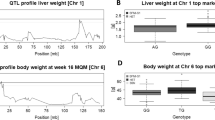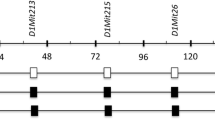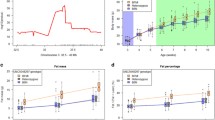Abstract
We previously identified a Chr 15 quantitative trait locus (QTL) Fob3b in lines of mice selected for high (Fat line) and low (Lean line) body fat content that represent a unique model of polygenic obesity. Here we genetically dissected the Fob3b interval by analyzing the phenotypes of eight overlapping congenic lines and four F2 congenic intercrosses and prioritized candidates by bioinformatics approaches. Analyses revealed that the Fob3b QTL consists of at least two separate linked QTLs Fob3b1 and Fob3b2. They exhibit additive inheritance and are linked in coupling with alleles originating from the Lean line, decreasing obesity-related traits. In further analyses, we focused on Fob3b1 because it had a larger effect on obesity-related traits than Fob3b2, e.g., the difference between homozygotes for adiposity index (ADI) percentage was 1.22 and 0.77% for Fob3b1 and Fob3b2, respectively. A set of bioinformatics tools was used to narrow down positional candidates from 85 to 4 high-priority Fob3b1 candidates. A previous single Fob3b QTL was therefore resolved into another two closely linked QTLs, confirming the fractal nature of QTLs mapped at low resolution. The interval of the original Fob3b QTL was narrowed from 22.39 to 4.98 Mbp for Fob3b1 and to 7.68 Mbp for Fob3b2, which excluded the previously assigned candidate squalene epoxidase (Sqle) as the causal gene because it maps proximal to refined Fob3b1 and Fob3b2 intervals. A high-resolution map along with prioritization of Fob3b1 candidates by bioinformatics represents an important step forward to final identification of the Chr 15 obesity QTL.



Similar content being viewed by others
References
Beigneux AP, Davies BSJ, Gin P, Weinstein MM, Farber E et al (2007) Glycosylphosphatidylinositol-anchored high-density lipoprotein-binding protein 1 plays a critical role in the lipolytic processing of chylomicrons. Cell Metab 5:279–291
Bunger L, Hill WG (1999) Inbred lines of mice derived from long-term divergent selection on fat content and body weight. Mamm Genome 10:645–648
Burgess-Herbert SL, Cox A, Tsaih SW, Paigen B (2008) Practical applications of the bioinformatics toolbox for narrowing quantitative trait loci. Genetics 180:2227–2235
Casas E, Shackleford SD, Keele JW, Stone RT, Kappes SM et al (2000) Quantitative trait loci affecting growth and carcass composition of cattle segregating alternate forms of myostatin. J Anim Sci 78:560–569
Casas E, Shackelford SD, Keele JW, Koohmaraie M, Smith TPL et al (2003) Detection of quantitative trait loci for growth and carcass composition in cattle. J Anim Sci 81:2976–2983
Chen HC (2006) Enhancing energy and glucose metabolism by disrupting triglyceride synthesis: lessons from mice lacking DGAT1. Nutr Metab 3:10
Chen HC, Smith SJ, Ladha Z, Jensen DR, Ferreira LD et al (2002) Increased insulin and leptin sensitivity in mice lacking acyl CoA: diacylglycerol acyltransferase 1. J Clin Invest 109:1049–1055
Chiu S, Kim K, Haus KA, Espinal GM, Millon LV et al (2007) Identification of positional candidate genes for body weight and adiposity in subcongenic mice. Physiol Genomics 31:75–85
Christians JK, Keightley PD (2004) Fine mapping of a murine growth locus to a 1.4-cM region and resolution of linked QTL. Mamm Genome 15:482–491
Christians JK, Hoeflich A, Keightley PD (2006) PAPPA2, an enzyme that cleaves an insulin-like growth-factor-binding protein, is a candidate gene for a quantitative trait locus affecting body size in mice. Genetics 173:1547–1553
DiPetrillo K, Wang XS, Stylianou IM, Paigen B (2005) Bioinformatics toolbox for narrowing rodent quantitative trait loci. Trends Genet 21:683–692
Dokmanovic-Chouinard M, Chung WK, Chevre JC, Watson E, Yonan J et al (2008) Positional cloning of “Lisch-like”, a candidate modifier of susceptibility to type 2 diabetes in mice. PLoS Genet 4(7):e1000137
Farber CR, Medrano JF (2007) Fine mapping reveals sex bias in quantitative trait loci affecting growth, skeletal size and obesity-related traits on mouse chromosomes 2 and 11. Genetics 175:349–360
Fawcett GL, Jarvis JP, Roseman CC, Wang B, Wolf JB et al (2009) Fine-mapping of obesity-related quantitative trait loci in an F(9/10) advanced intercross line. Obesity (Silver Spring) [Epub ahead of print]
Flint J, Mackay TFC (2009) Genetic architecture of quantitative traits in mice, flies, and humans. Genome Res 19:723–733
Flint J, Mott R (2001) Finding the molecular basis of quantitative traits: Successes and pitfalls. Nat Rev Genet 2:437–445
Gelman A, Hill J (2007) Data analysis using regression and multilevel/hierarchical models. Cambridge University Press, New York
Graham D, McBride MW, Brain NJ, Dominiczak AF (2005) Congenic/consomic models of hypertension. Methods Mol Med 108:3–15
Grubb SC, Maddatu TP, Bult CJ, Bogue MA (2009) Mouse phenome database. Nucleic Acids Res 37:D720–D730
Hasegawa J, Osatomi K, Wu RF, Uyeda K (1999) A novel factor finding to the glucose response elements of liver pyruvate kinase and fatty acid synthase genes. J Biol Chem 274:1100–1107
Horvat S, Bunger L, Falconer VM, Mackay P, Law A et al (2000) Mapping of obesity QTLs in a cross between mouse lines divergently selected on fat content. Mamm Genome 11:2–7
Hu ZL, Fritz ER, Reecy JM (2007) AnimalQTLdb: a livestock QTL database tool set for positional QTL information mining and beyond. Nucleic Acids Res 35:D604–D609
Jerez-Timaure NC, Eisen EJ, Pomp D (2005) Fine mapping of a QTL region with large effects on growth and fatness on mouse chromosome 2. Physiol Genomics 21:411–422
Keightley PD, Morris KH, Ishikawa A, Falconer VM, Oliver F (1998) Test of candidate gene quantitative trait locus association applied to fatness in mice. Heredity 81:630–637
Laird PW, Zijderveld A, Linders K, Rudnicki MA, Jaenisch R et al (1991) Simplified mammalian DNA isolation procedure. Nucleic Acids Res 19:4293–4293
Lunn DJ, Thomas A, Best N, Spiegelhalter D (2000) WinBUGS—a Bayesian modelling framework: concepts, structure, and extensibility. Stat Comput 10:325–337
Lyons PA, Armitage N, Lord CJ, Phillips MS, Todd JA et al (2001) Mapping by genetic interaction—high-resolution congenic mapping of the type 1 diabetes loci Idd10 and Idd18 in the NOD mouse. Diabetes 50:2633–2637
Maes HHM, Neale MC, Eaves LJ (1997) Genetic and environmental factors in relative body weight and human adiposity. Behav Genet 27:325–351
Matsuda D, Tomoda H (2007) DGAT inhibitors for obesity. Curr Opin Invest Drugs 8:836–841
McDaniel AH, Li X, Tordoff MG, Bachmanov AA, Reed DR (2006) A locus on mouse Chromosome 9 (Adip5) affects the relative weight of the gonadal but not retroperitoneal adipose depot. Mamm Genome 17:1078–1092
Morton NM, Densmore V, Wamil M, Ramage L, Nichol K et al (2005) A polygenic model of the metabolic syndrome with reduced circulating and intra-adipose glucocorticoid action. Diabetes 54:3371–3378
Mott R, Flint J (2008) Prospects for complex trait analysis in the mouse. Mamm Genome 19:306–308
Plummer M, Best N, Cowles K, Vines K (2006) CODA: convergence diagnosis and output analysis for MCMC. R News 6(1):7-11. http://CRAN.R-project.org/doc/Rnews/Rnews_2006-1.pdf. Accessed 22 Feb 2010
Pomp D, Nehrenberg D, Estrada-Smith D (2008) Complex genetics of obesity in mouse models. Annu Rev Nutr 28:331–345
R Development Core Team (2008) R: a language and environment for statistical computing. R version 2.8.1. R Foundation for Statistical Computing, Vienna, ISBN 3-900051-07-0. http://www.r-project.org
Rance KA, Hambly C, Dalgleish G, Fustin JM, Bunger L et al (2007) Quantitative trait loci for regional adiposity in mouse lines divergently selected for food intake. Obesity (Silver Spring) 15:2994–3004
Rankinen T, Zuberi A, Chagnon YC, Weisnagel SJ, Argyropoulos G et al (2006) The human obesity gene map: the 2005 update. Obesity 14:529–644
Rocha JL, Eisen EJ, Van Vleck LD, Pomp D (2004) A large-sample QTL study in mice: II. Body composition. Mamm Genome 15:100–113
Rogner UC, Avner P (2008) Sourcebook of models for biomedical research. Humana Press, Totowa
Scherneck S, Nestler M, Vogel H, Bluher M, Block MD et al (2009) Positional cloning of zinc finger domain transcription factor Zfp69, a candidate gene for obesity-associated diabetes contributed by mouse locus Nidd/SJL. PLoS Genet 5(7):e1000541
Sharp GL, Hill WG, Robertson A (1984) Effects of selection on growth, body-composition and food-intake in mice. 1. Responses in selected traits. Genet Res 43:75–92
Silver LM (1995) Mouse genetics: concepts and applications. Oxford University Press, Oxford
Simoncic M, Rezen T, Juvan P, Fievet C, Staels B et al (2008) Transcriptome analysis revealed association of some P450 genes with obesity in a polygenic obese mouse model. Acta Chim Slovenica 55:101–110
Smith SJ, Cases S, Jensen DR, Chen HC, Sande E et al (2000) Obesity resistance and multiple mechanisms of triglyceride synthesis in mice lacking Dgat. Nat Genet 25:87–90
Smith PL, Myers JT, Rogers CE, Zhou L, Petryniak B et al (2002) Conditional control of selectin ligand expression and global fucosylation events in mice with a targeted mutation at the FX locus. J Cell Biol 158:801–815
Spiegelhalter DJ, Best NG, Carlin BP, Van der Linde A (2002) Bayesian measures of model complexity and fit (with discussion). J R Stat Soc B 64(4):583–639
Stanford WL, Haque S, Alexander R, Liu XM, Latour AM et al (1997) Altered proliferative response by T lymphocytes of Ly-6A (Sca-1) null mice. J Exp Med 186:705–717
Sturtz S, Ligges U, Gelman A (2005) R2WinBUGS: a package for running WinBUGS from R. J Stat Softw 12:1–16
Stylianou IM, Christians JK, Keightley PD, Bunger L, Clinton M et al (2004) Genetic complexity of an obesity QTL (Fob3) revealed by detailed genetic mapping. Mamm Genome 15:472–481
Stylianou IM, Clinton M, Keightley PD, Pritchard C, Tymowska-Lalanne Z et al (2005) Microarray gene expression analysis of the Fob3b obesity QTL identifies positional candidate gene Sqle and perturbed cholesterol and glycolysis. Physiol Genomics 20:224–232
Thaller G, Kuhn C, Winter A, Ewald G, Bellmann O et al (2003) DGAT1, a new positional and functional candidate gene for intramuscular fat deposition in cattle. Anim Genet 34:354–357
Warden CH, Stone S, Chiu S, Diament AL, Corva P et al (2004) Identification of a congenic mouse line with obesity and body length phenotypes. Mamm Genome 15:460–471
Willer CJ, Speliotes EK, Loos RJF, Li SX, Lindgren CM et al (2009) Six new loci associated with body mass index highlight a neuronal influence on body weight regulation. Nat Genet 41:25–34
Wuschke S, Dahm S, Schmidt C, Joost HG, Al-Hasani H (2007) A meta-analysis of quantitative trait loci associated with body weight and adiposity in mice. Int J Obes (Lond) 31:829–841
Yalcin B, Willis-Owen SAG, Fullerton J, Meesaq A, Deacon RM et al (2004) Genetic dissection of a behavioral quantitative trait locus shows that Rgs2 modulates anxiety in mice. Nat Genet 36:1197–1202
Yen CLE, Stone SJ, Koliwad S, Harris C, Farese RV (2008) DGAT enzymes and triacylglycerol biosynthesis. J Lipid Res 49:2283–2301
Young SG, Davies BSJ, Fong LG, Gin P, Weinstein MM et al (2007) GPIHBP1: an endothelial cell molecule important for the lipolytic processing of chylomicrons. Curr Opin Lipidol 18:389–396
Zhang SM, Lou YG, Amstein TM, Anyango M, Mohibullah N et al (2005) Fine mapping of a major locus on Chromosome 10 for exploratory and fear-like behavior in mice. Mamm Genome 16:306–318
Acknowledgments
This project was supported by the Slovenian Research Agency (ARRS) young investigator grant and program grant P4-0220. Sincere thanks to all members of Beverly Paigen’s lab at the Jackson Laboratory for help with the bioinformatics. We thank Dr. McWhir for critical review of the manuscript and Ana Zanjkovic for excellent technical assistance with the mouse colony. Finally, we are grateful to two anonymous reviewers for meticulous review and constructive criticism that helped us improve the article.
Author information
Authors and Affiliations
Corresponding author
Electronic supplementary material
Below is the link to the electronic supplementary material.
Rights and permissions
About this article
Cite this article
Prevoršek, Z., Gorjanc, G., Paigen, B. et al. Congenic and bioinformatics analyses resolved a major-effect Fob3b QTL on mouse Chr 15 into two closely linked loci. Mamm Genome 21, 172–185 (2010). https://doi.org/10.1007/s00335-010-9252-z
Received:
Accepted:
Published:
Issue Date:
DOI: https://doi.org/10.1007/s00335-010-9252-z




